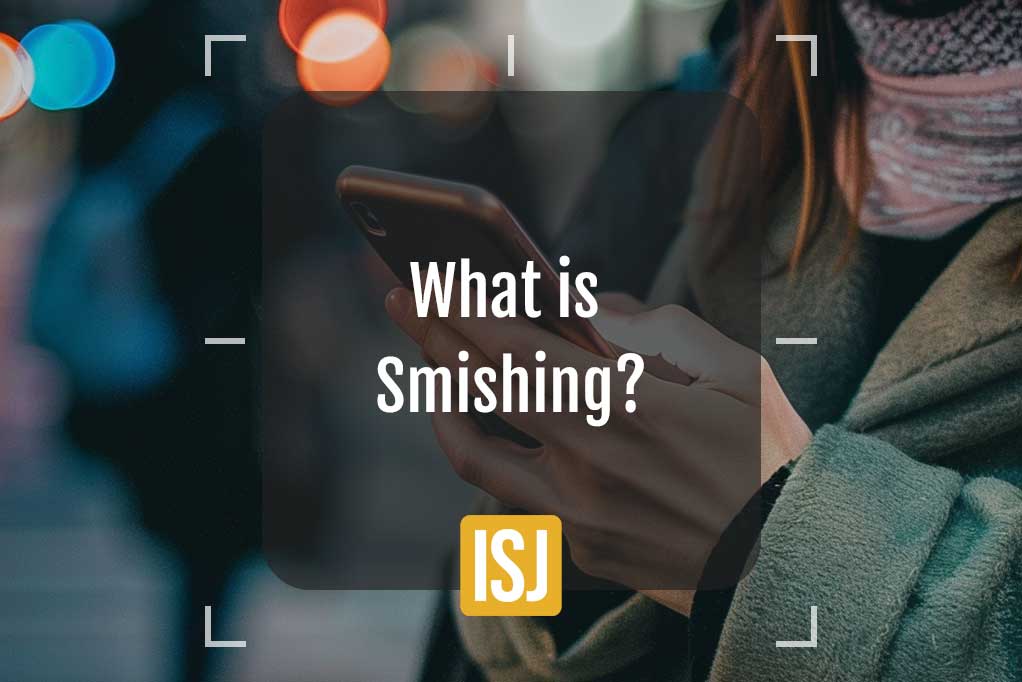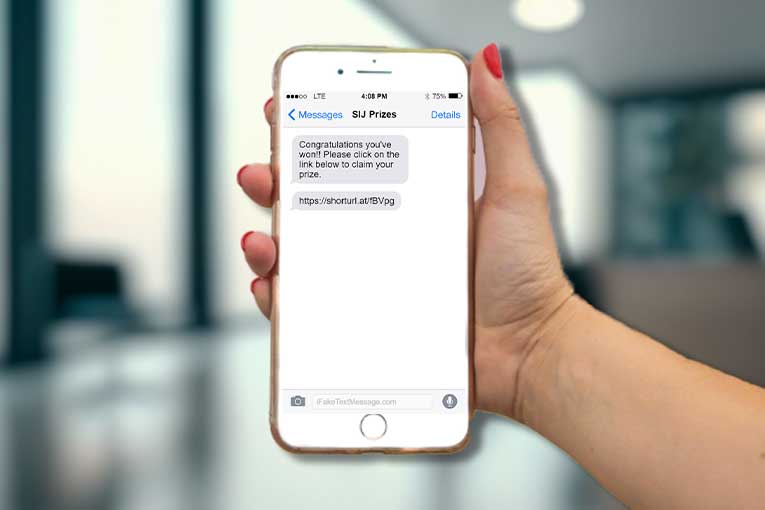What is Smishing?


Simon Burge
Share this content
In digital communication, scams have evolved beyond just emails and phone calls.
Scammers are using text messages to deceive people into revealing personal information.
This type of scam is known as “smishing,” a clever combination of “SMS” (Short Message Service) and “phishing.”
But exactly what is smishing?
In this article, we’ll explore what smishing is, how it works, the different types of smishing scams, how to identify smishing attempts, and most importantly, how to protect yourself from falling victim to smishing.
Article Chapters
ToggleWhat is Smishing?

Smishing is a form of phishing scam that occurs through text messages (SMS).
Scammers send fraudulent text messages pretending to be from legitimate organisations, such as banks, government agencies, or reputable companies.
These messages often contain urgent requests or alarming alerts, designed to prompt recipients to respond quickly without thinking.
The ultimate goal of smishing is to trick individuals into revealing personal or financial information, such as bank account numbers, credit card details, passwords, or other sensitive data.
Once scammers obtain this information, they can use it for identity theft, financial fraud, or other malicious purposes.
Smishing has become increasingly common since people now rely on their smartphones for communication, and scammers adapt their tactics to exploit new technologies.
Being aware of smishing scams and knowing how to identify and avoid them is essential for protecting yourself from falling victim to these fraudulent schemes.
How Does Smishing Work?

Here’s how smishing typically works:
Sending Fake Messages
Scammers send text messages pretending to be from legitimate organisations, such as banks, government agencies, or reputable companies.
Creating Urgency or Alarm
Smishing messages often contain urgent requests, alarming alerts, or enticing offers designed to prompt recipients to respond quickly without thinking.
Requesting Personal Information
The text messages may ask recipients to provide personal or financial information, such as bank account numbers, credit card details, passwords, or other sensitive data.
Providing Links
Smishing messages may also contain links to fake websites that closely resemble legitimate ones. These websites are designed to trick recipients into entering their information, which is then captured by the scammers.
Exploiting Trust
Scammers exploit the trust and credibility of well-known organisations to make their messages appear legitimate.
Consequences of Falling Victim
Once scammers obtain this information, they can use it for identity theft, financial fraud, or other malicious purposes.
Types of Smishing

Smishing scams come in various forms, each designed to deceive individuals into providing personal or financial information.
Here are some common types of smishing:
Financial Smishing
In this type of smishing, scammers impersonate banks or financial institutions.
They send text messages claiming there is an issue with the recipient’s account or that they need to verify their account information.
The message typically includes a link to a fake website where recipients are asked to enter their account details, which are then captured by the scammers.
Prize Smishing
Scammers send text messages claiming that the recipient has won a prize, such as a gift card, vacation, or cash reward.
To claim the prize, recipients are asked to provide personal information, such as their name, address, phone number, or credit card details.
However, there is no prize, and the scammers use this information for identity theft or financial fraud.
Security Alert Smishing
In this type of smishing, scammers pretend to be from a security agency or company and claim that there has been suspicious activity on the recipient’s account.
The message warns the recipient to take immediate action to secure their account and includes a link to a fake website where they are asked to enter their login credentials or other personal information.
Delivery Smishing
Scammers send text messages pretending to be from a delivery service, such as FedEx or UPS.
The message claims that there is an issue with a delivery and asks the recipient to click on a link to track the package or reschedule the delivery.
However, the link leads to a fake website where the recipient is asked to provide personal information.
What to do if you Get Scammed by Smishing

If you fall victim to a smishing scam, it’s important to take immediate action to protect yourself and minimise the damage.
Here’s what you should do if you get scammed by smishing:
Don’t Respond
The first and most crucial step is not to respond to the smishing message.
Do not reply to the text message or click on any links contained within it.
Report it
Forward the suspicious message to your mobile carrier.
This will help your carrier identify and block future smishing attempts.
Additionally, report the smishing message to the Federal Trade Commission (FTC).
Monitor Your Accounts
Keep a close eye on your bank and credit card accounts for any unauthorised transactions.
If you provided any personal or financial information in response to the smishing message, contact your bank or credit card company immediately to report the fraud and take steps to protect your accounts.
Update Your Security Settings
Review and update the security settings on your mobile device to prevent future smishing attempts.
Consider enabling two-factor authentication for an added layer of security.
Stay Vigilant
Remain vigilant for future smishing attempts and be cautious of unsolicited text messages, especially those that ask for personal or financial information.
If you receive a text message that seems suspicious, verify the sender’s identity by contacting the organisation directly using a verified phone number or website.
How to Identify Smishing

Identifying smishing attempts can help you avoid falling victim to fraudulent schemes. Here are some common signs to look out for:
Urgency
Smishing messages often create a sense of urgency or panic, urging you to act quickly.
They may claim that your account has been compromised, or that you need to verify your information immediately.
Suspicious Links
Be wary of text messages that contain links to websites. Scammers often use fake websites to collect personal information.
Hover your cursor over the link (without clicking on it) to see the URL. If it looks suspicious or doesn’t match the purported sender, it’s likely a smishing attempt.
Grammatical Errors
Many smishing messages contain spelling or grammatical errors.
Legitimate organisations typically have professional communication standards and would not send out messages with obvious mistakes.
Requests for Personal Information
Be cautious of any text message that asks for personal or financial information, such as your Social Security number, bank account details, or passwords.
Legitimate organisations would not ask for this information via text message.
Unknown Sender
If you receive a text message from an unknown sender, especially one claiming to be from a reputable organisation, it’s likely a smishing attempt.
Be cautious of messages from unknown or unusual sender numbers.
Scammers often use spoofing techniques to make it appear as though the message is coming from a trusted source.
Offers Too Good to be True
Smishing messages may promise prizes, discounts, or other offers that seem too good to be true.
If it seems too good to be true, it probably is.
How to Protect Yourself From Smishing

Protecting yourself from smishing scams requires vigilance and awareness.
Here are some tips to help you avoid falling victim to these fraudulent schemes:
Be Sceptical
Be cautious of unsolicited text messages, especially those that create a sense of urgency or panic.
If a message seems suspicious, trust your instincts and proceed with caution.
Verify the Sender
Verify the identity of the sender before responding to any text message.
Contact the organisation directly using a verified phone number or website to confirm the legitimacy of the message.
Don’t Click on Links
Avoid clicking on links in text messages from unknown senders.
These links may lead to fake websites designed to steal your personal information.
Don’t Respond to Requests
Never provide personal or financial information in response to a text message, especially if it’s from an unknown sender.
Legitimate organisations would not ask for this information via text message.
Use Security Software
Install reputable security software on your mobile device to help protect against smishing and other forms of cybercrime.
Keep your software up to date to ensure you have the latest protection.
Enable Two-Factor Authentication
Enable two-factor authentication for your accounts whenever possible.
This adds an extra layer of security by requiring a second form of verification, such as a code sent to your phone, in addition to your password.
Educate Yourself
Stay informed about the latest smishing scams and tactics.
Knowledge is your best defence against cybercrime.
Conclusion
Hopefully you now have an understanding of exactly what is smishing.
Smishing is still a growing threat, but by staying vigilant and following these tips, you can protect yourself from falling victim to smishing and other cybersecurity scams.
Remember to be cautious of unsolicited text messages, avoid clicking on suspicious links, and verify the legitimacy of messages before responding.
By taking these simple precautions, you can keep your personal information safe and secure.

